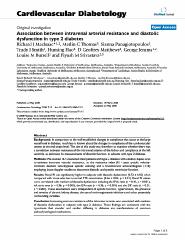Please use this identifier to cite or link to this item:
https://ahro.austin.org.au/austinjspui/handle/1/10614| Title: | Association between intrarenal arterial resistance and diastolic dysfunction in type 2 diabetes. | Austin Authors: | MacIsaac, Richard J;Thomas, Merlin C;Panagiotopoulos, Sianna ;Smith, Trudy J;Hao, Huming ;Matthews, D Geoffrey;Jerums, George ;Burrell, Louise M ;Srivastava, Piyush M | Affiliation: | Endocrine Centre, Austin Health & University of Melbourne, Melbourne, Australia | Issue Date: | 23-May-2008 | Publication information: | Cardiovascular Diabetology 2008; 7: 15 | Abstract: | In comparison to the well established changes in compliance that occur at the large vessel level in diabetes, much less is known about the changes in compliance of the cardiovascular system at the end-organ level. The aim of this study was therefore to examine whether there was a correlation between resistance of the intrarenal arteries of the kidney and compliance of the left ventricle, as estimated by measurements of diastolic function, in subjects with type 2 diabetes.We studied 167 unselected clinic patients with type 2 diabetes with a kidney duplex scan to estimate intrarenal vascular resistance, i.e. the resistance index (RI = peak systolic velocity-minimum diastolic velocity/peak systolic velocity) and a transthoracic echocardiogram (TTE) employing tissue doppler studies to document diastolic and systolic ventricular function.Renal RI was significantly higher in subjects with diastolic dysfunction (0.72 +/- 0.05) when compared with those who had a normal TTE examination (0.66 +/- 0.06, p < 0.01). Renal RI values were correlated with markers of diastolic dysfunction including the E/Vp ratio (r = 0.41, p < 0.001), left atrial area (r = 0.36, p < 0.001), the E/A ratio (r = 0.36, p < 0.001) and the E/E' ratio (r = 0.31, p < 0.001). These associations were independent of systolic function, hypertension, the presence and severity of chronic kidney disease, the use of renin-angiotensin inhibitors and other potentially confounding variables.Increasing vascular resistance of the intrarenal arteries was associated with markers of diastolic dysfunction in subjects with type 2 diabetes. These findings are consistent with the hypothesis that vascular and cardiac stiffening in diabetes are manifestations of common pathophysiological mechanisms. | Gov't Doc #: | 18500986 | URI: | https://ahro.austin.org.au/austinjspui/handle/1/10614 | DOI: | 10.1186/1475-2840-7-15 | ORCID: | 0000-0003-1863-7539 0000-0002-0845-0001 |
Journal: | Cardiovascular diabetology | URL: | https://pubmed.ncbi.nlm.nih.gov/18500986 | Type: | Journal Article | Subjects: | Adult Aged Compliance Diabetes Mellitus, Type 2.complications.physiopathology Diabetic Angiopathies.physiopathology Diastole.physiology Echocardiography Female Humans Kidney.blood supply Male Middle Aged Renal Artery.physiology Vascular Resistance.physiology Ventricular Dysfunction, Left.physiopathology.ultrasonography |
| Appears in Collections: | Journal articles |
Files in This Item:
| File | Description | Size | Format | |
|---|---|---|---|---|
| 18500986.pdf | 268.3 kB | Adobe PDF |  View/Open |
Page view(s)
48
checked on Nov 23, 2024
Download(s)
124
checked on Nov 23, 2024
Google ScholarTM
Check
Items in AHRO are protected by copyright, with all rights reserved, unless otherwise indicated.
